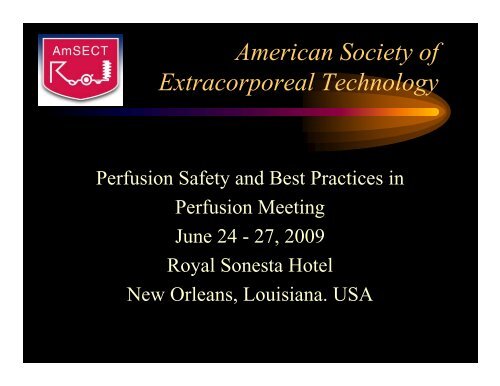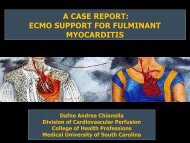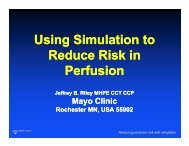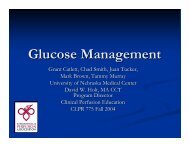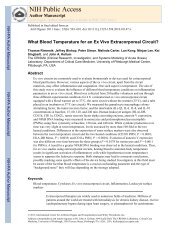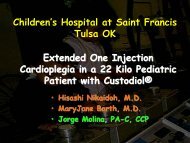PowerPoint Presentation (PDF) - Perfusion.com
PowerPoint Presentation (PDF) - Perfusion.com
PowerPoint Presentation (PDF) - Perfusion.com
Create successful ePaper yourself
Turn your PDF publications into a flip-book with our unique Google optimized e-Paper software.
American Society of<br />
Extracorporeal Technology<br />
<strong>Perfusion</strong> Safety and Best Practices in<br />
<strong>Perfusion</strong> Meeting<br />
June 24 - 27, 2009<br />
Royal Sonesta Hotel<br />
New Orleans, Louisiana. USA
Session II<br />
<strong>Perfusion</strong> Safety: Case Reports<br />
Session Objective:<br />
To increase patient safety measures<br />
and decrease patient accidents.<br />
Can the Somanetics technology help<br />
us to achieve this goal l?
Cape Cod Hospital<br />
Cardiac Surgery Program<br />
in Partnership with<br />
Brigham & Women’s Hospital
Cape Cod Hospital<br />
Cardiac Surgery Program<br />
• 2002 – 2005<br />
• 355 Primary CABG<br />
• CVA 0.0 0 (0%)<br />
• Mortality 2/355 (0.6%)<br />
• 2002 - 2009<br />
• 659 Primary CABG<br />
• CVA 1/659 (0.015%)<br />
• Mortality 8/659 (1.2%)
Introduction to Cerebral Oximetry
Skull<br />
How the INVOS System Works<br />
Two depths of light penetration are<br />
used to subtract out data from the<br />
skin and skull, resulting in blood<br />
oxygen saturation for deeper tissues<br />
directly underneath the sensor.<br />
Skin<br />
Light<br />
Emitting<br />
Diode<br />
Surface<br />
Photodetector<br />
SomaSensor<br />
Cerebral<br />
Cortex<br />
Deep<br />
Photodetector
Normative Range for rSO2<br />
• Adult cardiac patients 67±10<br />
• Left-Right differences: 5% were >10<br />
• 5% rSO2 baseline values < 50<br />
• 1.6% rSO2 baseline values < 40<br />
• Strong positive correlation with hemoglobin<br />
concentration
Transcranial Cerebral Oximetry<br />
On CPB<br />
Flow Down<br />
Han SH et al: The effect of bloodless pump prime on cerebral oxygenation<br />
in pediatric patients. Acta Anaesthesiol Scand 48:648-652, 2004
Minimal Priming Volume Strategy<br />
Autologus Blood Priming Technique<br />
Priming Volume 800 -1000 ml Normosol
Transcranial Cerebral Oximetry<br />
On CPB
Judging the Adequacy of <strong>Perfusion</strong><br />
Global Measures:<br />
• SVO2 Monitor<br />
• Mean arterial pressure<br />
• Blood flow index (1.8 – 2.4)<br />
• CVP<br />
• Arterial PO2, PCO2<br />
• Venous PO2<br />
• Base Deficit<br />
• Urine output
Transcranial Cerebral Oximetry<br />
Reop. CABG<br />
Kinked Venous Cannula
Determinants of Regional<br />
Cerebral Oxygen Saturation (rSO2)<br />
• Cerebral <strong>Perfusion</strong> Pressure (CPP)<br />
• CPP = MAP – CVP<br />
• Blood flow rate<br />
• PaCO 2<br />
• PaO 2 (FIO 2 )<br />
• Oxygen carrying capacity (HCT)<br />
• Arterial inflow temperature<br />
• Intact cerebral circulation<br />
i
Transcranial Cerebral Oximetry<br />
Taking Venous Return
Transcranial Cerebral Oximetry<br />
EDVH
Transcranial Cerebral Oximetry<br />
EDVH
Transcranial Cerebral Oximetry<br />
Anes Jet Lag
Transcranial Cerebral Oximetry<br />
CCP Jet Lag
Baseline Asymmetry > 10<br />
• Carotid or Intracranial stenosis<br />
• Intracranial space-occupying lesion<br />
• Prior cerebral infarction<br />
• Hemangioma<br />
• Frontal sinus fluid<br />
• Skull defect<br />
• Subclavian steal
Transcranial Cerebral Oximetry<br />
# 614221 Air Embolism<br />
Innominate Art.<br />
90<br />
80<br />
70<br />
60<br />
50<br />
40<br />
30<br />
20<br />
10<br />
0<br />
Left<br />
Right
Transcranial Cerebral Oximetry<br />
• June 16, 2009<br />
• 73 y o Retired University President<br />
• Admit with USA<br />
• Cath; 3VD, AVA < 0.7, 5 CM AAA<br />
• PMH: HTN, IDDM, + Lipids, HB (Pacer)<br />
• Meds: ASA, HCTZ, Lipitor, Insulin<br />
Lisinopril.
Transcranial Cerebral Oximetry
AUC – Quantifying Risk<br />
O 2<br />
rSO<br />
90<br />
80<br />
70<br />
Baseline<br />
60<br />
50 25% from Baseline<br />
40<br />
Area Below 25% from Baseline (min%)<br />
30<br />
8:00 8:30 9:00 9:30 10:00 10:30 11:00 11:30<br />
• AUC<br />
(Area Under the Curve)<br />
Quantifies the depth<br />
and duration below<br />
the critical i threshold<br />
h of 25% below baseline<br />
• High AUC has been<br />
correlated with adverse<br />
out<strong>com</strong>es<br />
Murkin JM, et al. Anesth Analg 2007;7(6):515
Common Interventions to Correct<br />
Declining Cerebral Oxygen Saturation*<br />
• Increase blood flow rate (39pts) (67%)<br />
• Increase MAP (42pts) (62%)<br />
• Normalize PaCO 2 (34pts) (50%)<br />
• Deepen Anesthesia (27pts) (48%)<br />
• Increase FIO 2 (28pts) (43%)<br />
• Pulsatile Flow (6pts) (17%)<br />
• Check cannulas<br />
(both arterial & venous)<br />
• Increase oxygen carrying capacity<br />
(Murkin JM, A &A 2007<br />
* Intervention threshold >20% or below 50, Critical threshold > 25% or below 40
STS Database Fields<br />
As of January 1st, 2008 the following Cerebral Oximetry metrics<br />
will be collected by the STS Database:<br />
Pre-Induction Baseline Regional Oxygen Saturation:<br />
Left: ______ (%) Right _______ (%)<br />
Cumulative Saturation Below Threshold:<br />
Left: _____ (minute-%) Right _____ (minute-%)<br />
Cerebral Oximeter Provided The First Indication: Yes No<br />
Skin Closure Regional Oxygen Saturation:<br />
Left: _____ (%) Right _______ (%)
New rSO2 Asymmetry<br />
• Intraoperative Type A Dissection<br />
• Cannulation misadventures (art & ven)<br />
• Axial head rotation<br />
• Heart manipulation<br />
• Gaseous or particulate emboli<br />
• Subclavian steal
Transcranial Cerebral Oximetry<br />
Anemia on CPB<br />
90<br />
80<br />
70<br />
60<br />
50<br />
40<br />
30<br />
20<br />
10<br />
0<br />
Lef t<br />
Right
The Effect of Age on the Brain<br />
• Over age 65<br />
15% carotid stenosis.<br />
> 50%<br />
• 30% “Silent Infarcts”<br />
• HTN- narrows the<br />
deep penetrating<br />
vessels.<br />
• Loss of Cerebral<br />
Autoregulation<br />
Sieber FE, Geriatric Anesthesia; 2007:McGraw Hill Co.
Hour rs<br />
200<br />
Control, Diabetics, n=26<br />
Interventions, Diabetics, n=30<br />
Randomized, prospective, blinded<br />
160<br />
120<br />
80<br />
40 30<br />
0<br />
9<br />
Ventilation*<br />
Study Findings<br />
Bringing g Diabetics in Sync with Non-Diabetics<br />
69<br />
Murkin JM, et al. Anesth Analg 2005;100:SCA101<br />
201.6<br />
Diabetic cardiac surgery patients<br />
monitored with the INVOS System.<br />
Reductions in ventilation time, ICU<br />
time, and LOS were statistically<br />
significant.<br />
132 “Clinical out<strong>com</strong>es were improved to<br />
the point that there were no significant<br />
differences between diabetics i and<br />
non-diabetics, essentially leveling the<br />
playing field for patients who<br />
30 traditionally have had poorer<br />
out<strong>com</strong>es during cardiac surgery.”<br />
ICU Stay* Hospital Stay*<br />
John M. Murkin, MD<br />
Professor of Anesthesiology<br />
University of Western Ontario,<br />
London, Ontario, Canada<br />
Murkin JM, et al. Anesth Analg 2005;100:SCA101.
Study Findings<br />
3% of the rSO2 managed group experienced MOMM<br />
<strong>com</strong>pared to 11% in the control group <strong>com</strong>pared with<br />
13.4% for the STS database<br />
14<br />
13.4%<br />
12<br />
11%<br />
− Death within 30 days<br />
− Permanent stroke<br />
10<br />
− > 48 hours ventilation<br />
8<br />
− Renal failure requiring dialysis<br />
%<br />
6<br />
− Re-operation for any reason<br />
4<br />
3%* − Mediastinitis/deep sternal<br />
infection<br />
2<br />
0<br />
Morbidity<br />
(p
Neonatal l& Pediatric Monitoring
Benefits of Cerebral Oximetry<br />
• Improved Neurocognitive Function<br />
• Shortened ICU/ Hospital Stay<br />
• Decreased Stroke Rate<br />
• Detection of Cerebral Malperfusion<br />
• Early warning of Oxygen Delivery Failure<br />
• Detection of Cerebral Vasospasm<br />
• ? Transfusion Trigger
Session II<br />
<strong>Perfusion</strong> Safety: Case Reports<br />
Session Objective:<br />
To increase patient safety measures<br />
and decrease patient accidents.<br />
Can the Somanetics technology help<br />
us to achieve this goal l?
Cape Cod Hospital<br />
Cardiac Surgery Program
Adoption to Date<br />
• 645 Centers (adult &<br />
pediatric) nationwide<br />
• 185 ,000 procedures<br />
annually<br />
• 500+ Clinical<br />
references that speak<br />
to its clinical value<br />
• Supported by direct<br />
sales and clinical<br />
specialists coast-tocoast<br />
– International distributors<br />
Tyco Healthcare and<br />
Edwards LifeSciences
Intra-Operative Strategies to Avoid<br />
Adverse Neurologic Out<strong>com</strong>es<br />
Minimize the number<br />
of Cerebral Emboli<br />
Avoid Cerebral<br />
Hypo-<strong>Perfusion</strong><br />
Attenuate the Whole Body<br />
Inflammatory Response<br />
Epi-Aotic Scanning<br />
CPB Filtration.<br />
Single Cross Clamp<br />
Min. Card. Suction<br />
Thermal Management<br />
Acid Base Mgt.<br />
Neurologic Monitoring<br />
VAVD<br />
Surface Coatings<br />
Min Cardiotomy Suction<br />
Pharmacological Mgt.<br />
Anti-coagulation Mgt.<br />
Murkin JM, et al. Attenuation of Neurologic Injury During Cardiac Surgery.<br />
Ann Thorac Surg 2001;72: S1838-S1844<br />
Lill KJ t l O ti d P f i St t t Att t Ad<br />
Lilly KJ, et al. Operative and <strong>Perfusion</strong> Strategy to Attenuate Adverse<br />
Neurologic Out<strong>com</strong>es. <strong>Perfusion</strong> 2006; 21:1-7
Study Findings<br />
• ICU Length Of Stay for the intervention group was significantly shorter<br />
• Standard Deviation was also tighter, indicating fewer outlier patients<br />
5<br />
4<br />
Monitored<br />
Unmonitored<br />
±2.7<br />
Da ays<br />
3<br />
2<br />
1<br />
0<br />
±0.8<br />
1.25 1.87<br />
ICU Length of Stay<br />
(p
Study Design - Murkin<br />
Study Design and Hypothesis<br />
• Prospective, Randomized, Blinded, Cardiac Surgery Study<br />
• n = 200, (100 Control, 100 Intervention)<br />
• Data collected by an independent, blinded observer in an<br />
autonomous, protocol driven, “closed”, ICU<br />
Control Group<br />
n = 100, Blinded rSO2 Data Collection<br />
No Interventions<br />
R<br />
Intervention Group<br />
n = 100, rSO2 Data Collection<br />
Interventions per Protocol<br />
Murkin JM, et al. Anesth Analg 2007;7(6):515
Data Summary Page<br />
Data Base Summary in Run Mode
Judging the Adequacy of f<strong>Perfusion</strong>
INVOS:IN VIVO OPTICAL<br />
SPECTROSCOPY<br />
• LIGHT: NEAR- INFRARED LIGHT (NIRS)<br />
• WAVELENGTH 730+810 nm<br />
• 3 cm.depth DURA MATER+CSF<br />
• 4 cm. depth GRAY MATTER<br />
• PLACEMENT MID- FOREHEAD<br />
• VENOUS/ARTERIAL 75% VENOUS<br />
25% ART.
Post - Operative<br />
• Day 1, awoke with extreme agitation,<br />
treated with sedation (Propofol)<br />
• Day 3, Neuro Consult, Head CT & EEG<br />
Diagnosis: Metabolic Encephalopathy<br />
• Day 7, Propofol weaned agitation returned,<br />
Precedex started (1500 hrs)<br />
• Day 8, Woke up,followed <strong>com</strong>mands, weaning<br />
initiated, extubated by noon, Precedex D/C 1300<br />
• Day 16, Discharged to rehabilitation hospital.
<strong>Perfusion</strong> Management of Acute<br />
Ascending Aortic Dissection:<br />
Does Brain Monitoring Help?<br />
Kevin J. Lilly CCP, Paul A. Pirudini MD, Douglas Shook MD,<br />
Michaela A. Smith CCP, Pam DeVellis NP, Brian Gorsach PAC,<br />
Bruce Campbell RPh, Pauline Philie RN , Robert J. Rizzo MD<br />
Division of Cardiac Surgery<br />
Brigham & Women’s Hospital and Cape Cod Hospital<br />
Harvard Medical School
AAAD<br />
• October 19, 2005<br />
• 64 yo male admitted from Falmouth Hosp to OR.<br />
• PMH: HTN, Hyperlipidemia, Remote Tob.<br />
• Pt retired 5 days PTA from Biotech. Ind. (PhD)<br />
• CP while building walkway, relieved with rest.<br />
• CP returned next day along with leg numbness,<br />
• Leg weakness and ataxia, drove to local ER<br />
• Collapsed on presentation.
AAAD<br />
• Admitted R/O MI,<br />
?TIA<br />
• TEE: flap ascending<br />
aorta.<br />
• 4+AI
Classification of Aortic Dissections<br />
Cohn LC, Edmunds LH: Cardiac Surgery in the Adult.
AAAD – Otb October 192005 19, Type I Aortic Dissection
Acute Ascending Aortic<br />
Dissection<br />
Dec 30, 2005 - 10 weeks post discharge
Cape Cod Hospital<br />
Cardiac Surgery Program
The Future of Cardiac Surgery
Effect of Age on Neurologic<br />
Out<strong>com</strong>e in CABG Surgery<br />
Neurologic Events<br />
• < 65 yrs (0.9%)<br />
• < 74 yrs (3.6%)<br />
• > 75 yrs (8.9%) 10X<br />
N = 2000<br />
Tuman KJ et al, Differential effects of age on neurologic and cardiac risks of<br />
coronary artery operations. J Thorac Cardiovasc Surg. 1992 Dec; 104(6): 1510-7
Risk Factors Associated with<br />
Adverse Neurological Events<br />
Type I (Focal)<br />
• Advanced age<br />
• Aortic Atherosclerosis<br />
• Previous Stroke<br />
• Diabetes<br />
Type II (Non-Focal)<br />
• Advanced Age<br />
• HTN<br />
• COPD<br />
• ETOH
Incidence of Type I & Type II<br />
Adverse Neurological Events<br />
• Type I,( CVA, Focal<br />
Injury; Coma). 31% 3.1%<br />
Mortality = 21% vs 2%<br />
LOS = 25 days vs 10 days<br />
• Type II, Cognitive<br />
Dysfunction 30% 3.0%<br />
LOS = 21 days<br />
• N = 2108
The Effect of Aging on the Brain<br />
• Diminuation of Brain Mass<br />
• Decreased Neuronal Density<br />
• Decreased in <strong>com</strong>plexity of Neuronal<br />
Interconnections.<br />
• Increased Cerebrospinal Fluid (Hydrocephalus)<br />
• Reduced d production & function of<br />
Neurotransmitters<br />
Peters A, Structural changes in the normally aging cerebral cortex of primates.<br />
Prog Brain Res.2002;136:455-465
The Effect of Aging on the Brain<br />
Physiologic changes can result in:<br />
• Deterioration of gait, mobility & reflexes<br />
• Impairment of memory, intellect & executive<br />
function<br />
• Altered sleep patterns<br />
• Diminished vision, hearing, taste and smell.<br />
Sieber FE, Geriatric Anesthesia; 2007:McGraw Hill Co.
The Effect of Aging on the Brain<br />
The reduced production of Neurotransmitters:<br />
Acetylcholine<br />
Dopamine<br />
Norepinephrine<br />
Serotonin<br />
May be related to the development of Alzheimer’s<br />
Dementia, Parkinson's and may alter the brain’s<br />
sensitivity to volatile anesthetics
Cape Cod Hospital<br />
Cardiac Surgery Program
Cardiac Surgery Program<br />
CABG Results: CVA<br />
Year 2002 2003 2004 2005 2006<br />
STS 1.9% 1.9% 2.2% 1.8% 1.65%<br />
Predicted<br />
CVA Rate<br />
Actual<br />
CVA Rate<br />
0% 0% 0% 0% 0%
Cardiac Surgery Program<br />
CABG Results: Mortality<br />
Year 2002 2003 2004 2005 2006<br />
STS 2.53% 3.24% 3.43% 2.7% 3.64%<br />
Predicted<br />
Mortality<br />
Actual<br />
Mortality<br />
0% 0% 0% 1.9%<br />
(2)<br />
2.3%<br />
(2)
CCH Cardiac Surgery Program<br />
August 15, 2002 - August 31, 2007<br />
Isolated CABG 489<br />
Valve (all) 311<br />
Program<br />
mortality:<br />
16 / 844<br />
= 1.9%<br />
CABG/Other 19<br />
Aorta w/o CABG or Valve 7<br />
Tumor (+1) 5<br />
Other Cardiac Surgery 8<br />
Non pump OR cases 5<br />
Total lPump cases 843<br />
CPB assisted PCI 3<br />
TOTAL Cardiac surgery<br />
patients<br />
844
Cannulation Misadventures<br />
Cohn LC, Edmunds LH: Cardiac Surgery in the Adult.


